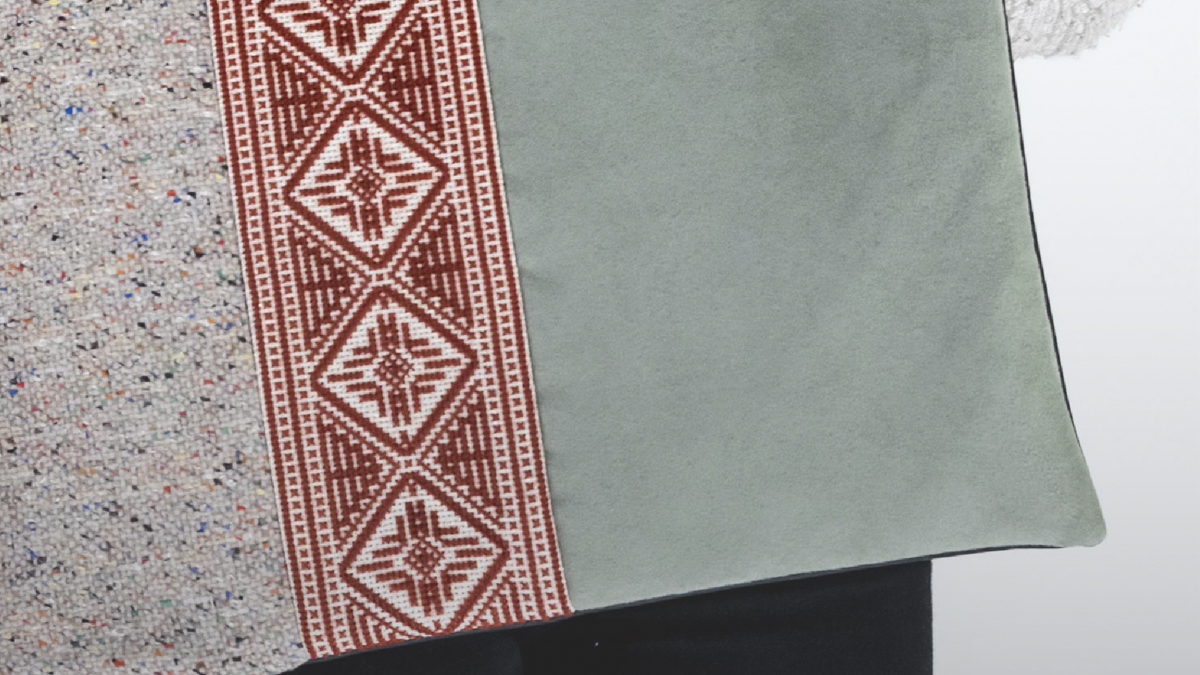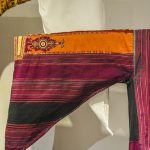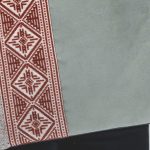A detail image of the Jordanian brand Tribalogy. Photo courtesy of Souq Fann.
ARABIC ARTICLE, ENGLISH TRANSLATION, & PHOTOS BY BATOOL AL-DULIGAN
Photos were taken at Tiraz Centre in Amman, Jordan. Special thanks to the centre’s staff for their help with the research for this article.
Traditional clothing in the Arab world is tied to traditions, heritage, and identity. Every Arab country has costumes that make it unique and distinct from other countries. Traditional embroidery patterns, for example, distinguish one nation’s clothing from another, acting like regional stamps or signatures.
Most of the thobes in Jordan and neighboring Palestine, in particular, tell the origin of the people who wear them. A thobe is a simply-constructed, floor-length dress with long sleeves. In Jordan and Palestine, “thobe” most often refers to these traditional garments worn by women, but in other parts of the Middle East, the term can refer to ankle-length garments for men. In this article, we’ll focus on women’s clothing. People can tell where a woman is from based on the colors and embroidery on her thobe.
According to some Palestinian historians, people began to wear thobes 3000 years ago, when the Canaanite civilization was at its height. Historians have found similar shapes and images in Palestinian traditional dresses as in the ancient Canaanite queens’ dresses, such as serpent and tree shapes, in addition to the color red, which is the most important embroidery color in both.
These days, women wear these traditional dresses only on special occasions such as weddings, national days, or other celebrations. They don’t wear them on a daily basis because people in today’s Arab countries tend to be trendy and wear modern outfits like jeans and suits.
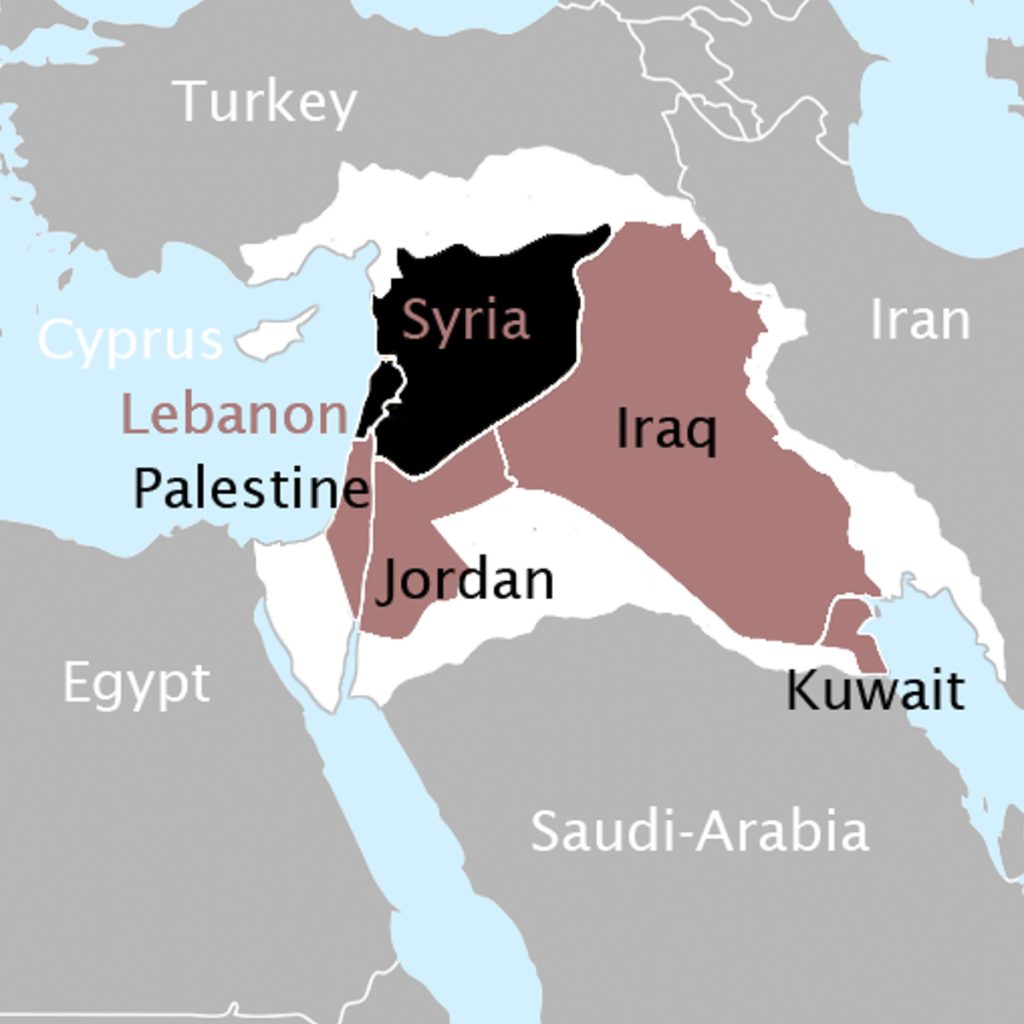
Original map provided by Wiki Commons.
In earlier eras, people applied the myths they believed in to the way they constructed their clothes. For example, they thought that the shape of a triangle on a thobe would protect them from envy and anything bad that could happen to them. Also, they thought that using silver, whether coins or other types of accessories, in their outfits could protect them from evil. In Palestine, men tended to adorn themselves with a lot of silver because they believed it could protect them from treacherous jinn and devils.
This week’s series of three articles will shed the light on women’s thobes in the Middle East, especially in Palestine and the Hashemite Kingdom of Jordan. It will highlight the differences between the shape of the embroidery and the style of these traditional dresses in different cities and regions.

The thobes from Beersheba, in southern Palestine, varied in color and embroidery depending on the wearer’s marital status.
Bringing the Past to the Present
Thobes were—and still are—the signature identity for every country and every region in the Arab world and the Middle East. They are the centerpiece in any national heritage event, such as Independence Day celebrations, because they are the cornerstone of heritage. Museums in Jordan and Palestine—such as the Tiraz Centre in Amman, which helps the community remember their heritage—are trying to protect these traditional costumes from fading into oblivion.
Some creators are trying to revive embroidery traditions and keep this heritage alive by combining the old embroideries with modern outfits. One of these designers is Mei Hayashi, who is the founder of Tribalogy, a Jordanian brand. Hayashi converts the traditional embroidery into modern designs by making makeup bags, laptop bags, purses, and totes, in addition to embroidered cushions.
Fashion designers such as Hayashi are producing high-quality handmade products with embroidery to prove to people how important traditions are and how adding traditional touches to modern products can be beautiful. Some of them succeed, and some of them fail during their process. But they are passionate enough to keep trying over and over again to let the concept of identity and heritage stay alive.
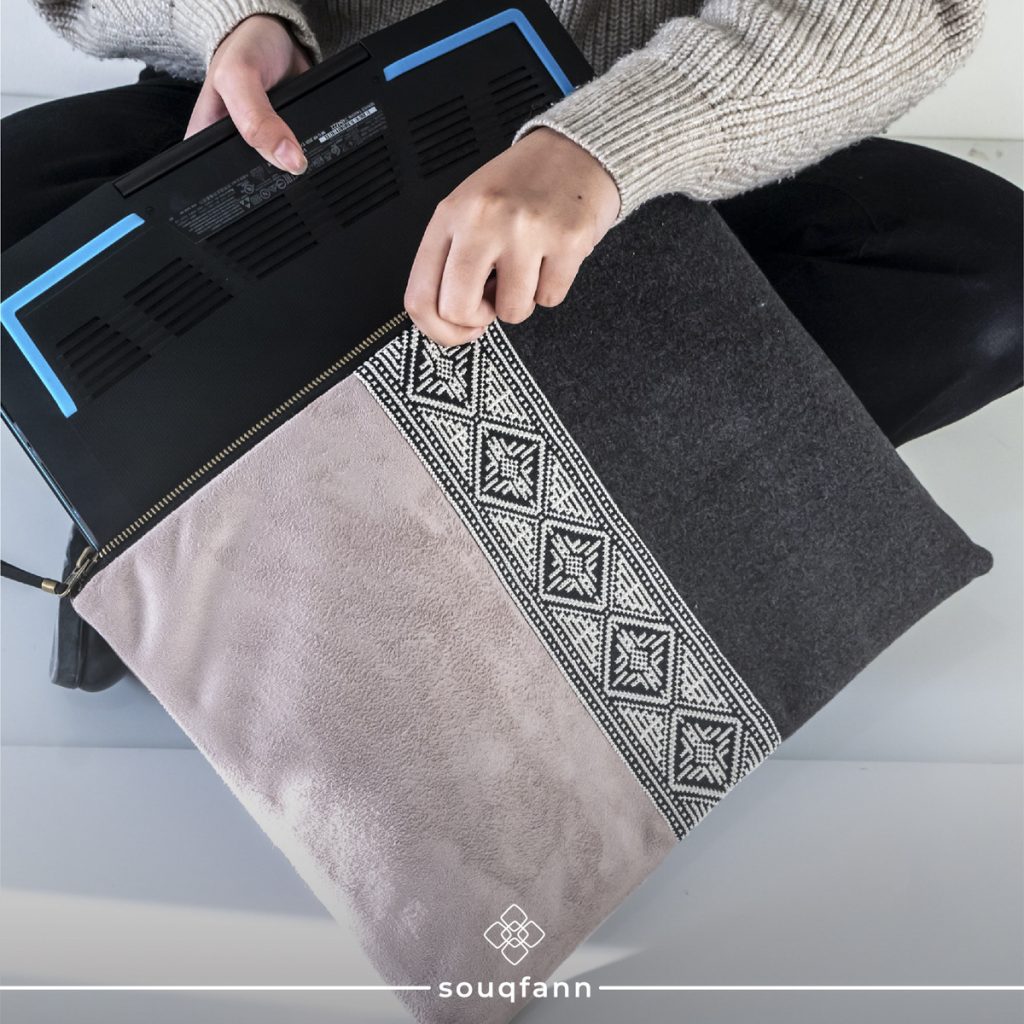
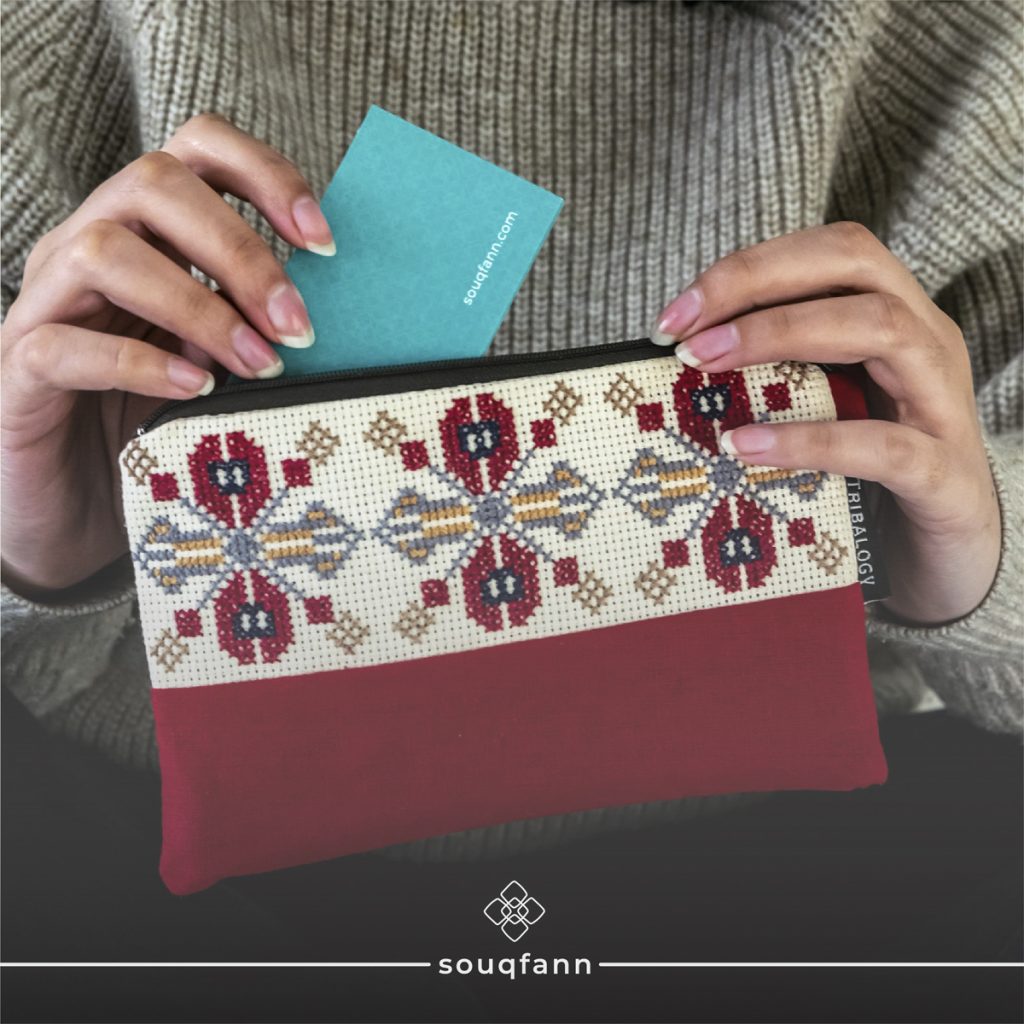
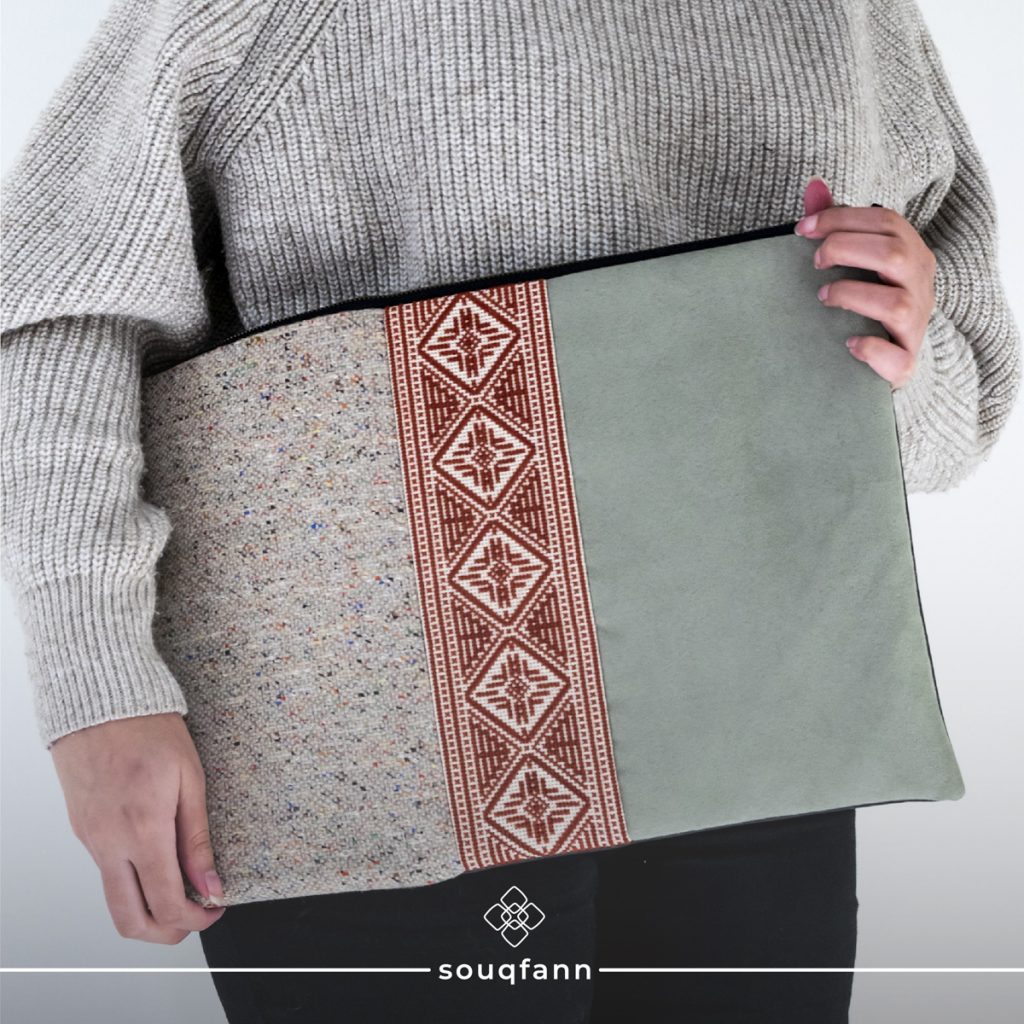
The Jordanian brand Tribalogy is reviving the handcraft of embroidery by applying traditional patterns to modern products. Photos courtesy of Souq Fann.
To browse a collection of handmade products featuring embroidery, visit Souq Fann, a Jordanian e-commerce website that supports local communities and the idea of reviving traditions and handicrafts through a modern approach.
Come back to Anthrow Circus on Wednesday and Friday this week for articles detailing the thobe designs of Palestine and Jordan!
يعتبر الزي التراثي والشعبي في الدول العربية وخاصة في منطقة الشرق الأوسط الركن الأساسي للتراث والعادات والتقاليد والهوية التي تعتبر ميزة لكل شخص. كل دولة في الوطن العربي تتميز بلباس شعبي خاص بها ويميزها عن باقي الدول لدرجة أنك تستطيع أن تعرف أصل الإنسان الذي قابلته من خلال شكل لباسه والتطريز المتواجد عليه. إن الزي التراثي ما هو الا بصمة، وعلامة، ومرجع وطني وقومي أساسي لكل شخص.
إن أغلب الأثواب تستطيع أن تُعرف عن صاحبها من دون أي كلمة وخصوصا في الأردن وفلسطين، حيث إن عامة الناس يمكنهم أن يخمنوا من لون الثوب ونوع التطريز المتواجد عليه.
بدأ الناس يرتدون الأثواب الشعبية قبل 3000 عام عندما كانت الحضارة الكنعانية في أوجها، وذلك طبقا لما قاله بعض علماء التاريخ الفلسطينيين. حيث أنهم وجدوا تشابه كبير بين الزي الشعبي الفلسطيني والفساتين التي كانت ترتديها ملكات الحضارة الكنعانية؛ فعلى سبيل المثال، رسومات الثعابين والأشجار كانت متواجدة في كلا الفستانين، إضافة إلى الألوان، حيث كان اللون الأحمر ومشتقاته هو اللون الرئيسي في معظم الأثواب.
أما حديثا، فأصبحت هذه الأثواب مجرد تراث يحتفظ به ويتم ارتداءه فقط في المناسبات الشخصية كالأعراس والحفلات وأيضا في المناسبات الرسمية كالأيام الوطنية والاحتفالات الشعبية لأن نمط الملابس قد اختلف بين الماضي والحاضر، إذ أصبحت الشعوب العربية أكثر حبا للموضة والتريند كالجينز والأطقم والفساتين العصرية.
كان المواطنون في تلك الحقبة يطبقون الخرافات والأساطير الذين يؤمنون بها في خياطة أثوابهم وملابسهم، فعلى سبيل المثال، كان الناس يعتقدون بأن شكل المثلث والذي يمثل شكل الحجب المختصة بالسحر والشعوذة يحميهم من أي شيء سيء سيحدث معهم. وكانوا يعتقدون أيضا بأن لبس الحلي من الفضة يحميهم من الشر.
أما بالنسبة للرجال، فغالبا يلبسون ثيابا عادية ولكنهم يستقصدون بأن يتزينوا بالفضة وخصوصا في فلسطين، لأنهم يظنون بأن الجن والشياطين تحب أن تؤذي جنس آدم، ولكن طاقة معدن الفضة تستطيع حماية الرجال من تلك الشياطين.
وبسبب هذه المعلومات البسيطة الشيقة عن الزي التراثي، سيسلط هذا المقال الضوء على لباس المرأة التراثي في منطقة الشرق الأوسط وخصوصا في الأردن وفلسطين، حيث إن هذا المقال سيتحدث عن الإختلافات بين الأثواب من حيث شكلها ونوع التطريز الخاص بها.
احياء التراث الشعبي في عصور الحداثة
كانت هذه الأثواب ومازالت الهوية الأساسية التي نفخر بها والبصمة التي تميز كل منطقة وكل مدينة في الوطن العربي والشرق الأوسط. تعتبر الأزياء الشعبية المشهد الأساسي والرئيسي لأي عرض وطني وقومي لأنها هي الوطنية والقومية بحد ذاتها.
بعض الناس يحاول أن يعيد احياء هذا التراث وخصوصا الحرفيين اليدويين الموهوبين الذين يفنون حياتهم فداء الحفاظ على هذا التراث وإعادة إحياءه بين الشباب من خلال دمج التطريز بالملابس العصرية، فبعضهم قد نجح والبعض الاخر ما زال يحاول ويعيد الكرة مرارا وتكرارا حتى يحقق مراده في زرع الفكرة التالية؛ بأن الهوية والتراث مازالوا على قيد الحياة في داخل قلوب وعقول كل الأجيال القديمة والحديثة. وتحاول معظم المتاحف بالاردن ومنهم طراز على مساعدة المجتمع المحلي في تذكر هذه الفكرة دائما من خلال الإهتمام الدائم بالتراث والعادات والتقاليد على الرغم من الانغماس في عصور الحداثة وما بعدها.
لمست التصاميم القديمة والتطاريز قلوب الكثير من المصممين العرب وغير العرب، ومن هؤلاء المصممين كانت السيدة ماي هياشي. تعرف السيدة هياشي بأنها مصممة أزياء يابانية درست وعملت على تطوير عملها في نيويورك وإيطاليا ومن ثم انتقلت إلى الأردن لتؤسس مشروعها الخاص “ترايبولوجي“. وهو مشروع ضخم جدا يتضمن نساء عربيات مساعدات ومساهمات بتقدم هذا المشروع من خلال حرفتهم اليدوية وسعيهم الدائم لكسب الرزق من عرق الجبين، إذ إن ترايبولوجي هو مشروع هدفه إعادة إحياء التراث الشعبي والتطريز ولكن بطريقة عصرية من خلال تصنيع حقائب يدوية، وحقائب لابتوب، ومخدات، وحقائب مكياج والعديد من المنتجات العصرية الممزوجة برائحة التراث من خلال التطريز، ففي متجر ترايبولوجي ستجدون كل ما تحتاجونه في عصركم هذا ولكن بشكل تراثي. فكان الهدف هو نقل تلك النظرية إلى منتجات ملموسة. ويجب أن لا ننسى أيضا وجود منصات تجارية الكترونية تدعم هذه المشاريع والحرف اليدوية والتطريز كمنصة سوق فن الموجودة في الأردن، وكل هذا الاهتمام هو لتأكيد أهمية التراث واستمراريته في عصور
Batool Al-Duligan is an Arab writer living in Amman, Jordan. She received her Bachelor of Arts degree in Applied English-Linguistics from the University of Jordan and her training in translating news articles at the Jordan News Agency in Amman. She is an opinion writer and columnist at Sasa Post and a marketer at Souq Fann, an e-commerce website and social enterprise that supports the local community and offers new opportunities for craftsmanship in Jordan.

